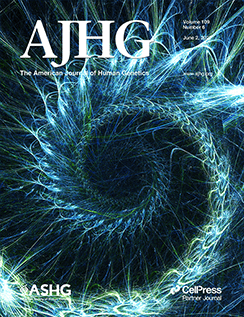在阿尔茨海默病的苍蝇和人类细胞模型中,计算和功能优先级确定了拯救行为和减少tau蛋白的基因。
IF 8.1
1区 生物学
Q1 GENETICS & HEREDITY
引用次数: 0
摘要
阿尔茨海默病(AD)的全基因组关联研究(GWASs)已经发现了70多个与AD风险显著相关的基因座,但由于时间和成本的限制,在这些基因座上识别真正的致病基因需要系统的功能验证,而这种验证很少进行。在这里,我们将转录组全关联研究(TWAS)与共定位分析、精细定位和AD GWAS变异的额外注释结合起来,确定了123个已知和提示AD风险位点的基因。与人类阿尔茨海默病脑转录组数据的比较证实,许多这些候选基因在人类阿尔茨海默病中失调,并与神经病理学相关。然后,我们在两个成熟的果蝇AD模型中测试了所有可用的同源基因,这些模型表达野生型tau或分泌型β-淀粉样蛋白(β42)。对60种候选基因的实验扰动确定了46种能在一种或两种果蝇模型中调节神经元功能障碍。其中18个基因的作用与TWAS的预测一致,因此,在AD苍蝇模型中,预测增加人类AD风险的错误表达方向加剧了行为障碍。逆转这些基因中的11个(MTCH2、ELL、TAP2、HDC、DMWD、MYCL、SLC4A9、ABCA7、CSTF1、PTK2B和CD2AP)的异常下调或上调,在体内证明了神经保护作用。我们进一步研究了MTCH2,发现它调节果蝇大脑中稳态tau蛋白水平,减少人类神经祖细胞中tau蛋白的积累。这种系统的、综合的方法有效地对GWAS基因座上的基因进行了优先排序,并揭示了有希望的ad相关候选基因,作为风险因素或治疗干预的靶点进行进一步研究。本文章由计算机程序翻译,如有差异,请以英文原文为准。
Computational and functional prioritization identifies genes that rescue behavior and reduce tau protein in fly and human cell models of Alzheimer disease.
Genome-wide association studies (GWASs) in Alzheimer disease (AD) have uncovered over 70 loci significantly associated with AD risk, but identifying the true causal gene(s) at these loci requires systematic functional validation that is rarely performed due to limitations of time and cost. Here, we integrate transcriptome-wide association study (TWAS) with colocalization analysis, fine-mapping, and additional annotation of AD GWAS variants to identify 123 genes at known and suggestive AD risk loci. A comparison with human AD brain transcriptome data confirmed that many of these candidate genes are dysregulated in human AD and correlate with neuropathology. We then tested all available orthologs in two well-established Drosophila AD models that express either wild-type tau or secreted β-amyloid (β42). Experimental perturbation of the 60 available candidates pinpointed 46 that modulated neuronal dysfunction in one or both fly models. The effects of 18 of these genes were concordant with the TWAS prediction, such that the direction of misexpression predicted to increase AD risk in humans exacerbated behavioral impairments in the AD fly models. Reversing the aberrant down- or upregulation of 11 of these genes (MTCH2, ELL, TAP2, HDC, DMWD, MYCL, SLC4A9, ABCA7, CSTF1, PTK2B, and CD2AP) proved neuroprotective in vivo. We further studied MTCH2 and found that it regulates steady-state tau protein levels in the Drosophila brain and reduces tau accumulation in human neural progenitor cells. This systematic, integrative approach effectively prioritizes genes at GWAS loci and reveals promising AD-relevant candidates for further investigation as risk factors or targets for therapeutic intervention.
求助全文
通过发布文献求助,成功后即可免费获取论文全文。
去求助
来源期刊
CiteScore
14.70
自引率
4.10%
发文量
185
审稿时长
1 months
期刊介绍:
The American Journal of Human Genetics (AJHG) is a monthly journal published by Cell Press, chosen by The American Society of Human Genetics (ASHG) as its premier publication starting from January 2008. AJHG represents Cell Press's first society-owned journal, and both ASHG and Cell Press anticipate significant synergies between AJHG content and that of other Cell Press titles.

 求助内容:
求助内容: 应助结果提醒方式:
应助结果提醒方式:


